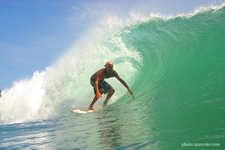 Surfers know the value they can get when coming to Bali, great waves, cheap food, friendly locals, warm weather, pretty girls and a laid back atmosphere. That has been the case for ages and other parts of Indonesia aren’t bad either. I have mates from Australia and the US who have told me they have had their best ever day of surfing, at places such as Nusa Dua, or Lakey Peak in Sumbawa. Another guy told me about sitting offshore waiting for the set and seeing turtles swim underneath. All this and more when you surf Indonesia. Women’s surfing champ Cynthia Web comments on the history of surfing in Indonesia.
Surfers know the value they can get when coming to Bali, great waves, cheap food, friendly locals, warm weather, pretty girls and a laid back atmosphere. That has been the case for ages and other parts of Indonesia aren’t bad either. I have mates from Australia and the US who have told me they have had their best ever day of surfing, at places such as Nusa Dua, or Lakey Peak in Sumbawa. Another guy told me about sitting offshore waiting for the set and seeing turtles swim underneath. All this and more when you surf Indonesia. Women’s surfing champ Cynthia Web comments on the history of surfing in Indonesia.
Surf’s up: Waves of change arrive in Indonesia via surf tourism
Cynthia Webb, Contributor, Gold Coast, Australia
It is possible that most Indonesians — and even the government — are not fully aware of the fact that ocean waves are one of Indonesia’s greatest tourist attractions, and that Indonesia is one of the world’s top surfing destinations.
However, for over 35 years the influence of surfing tourism has spread all over the country and Australians have played a major part in it.
For example, the presence of a magnificent surf break has radically changed the local economy and lifestyle at remote Lagundri Bay, southern Nias.
Dian Ediono, a Garuda Airlines manager based in Brisbane, said recently that the only group of travellers to Indonesia whose numbers didn’t diminish following the tragic bombings in Bali were the surfers.
Indonesia has surf spots from Aceh to West Timor whose names are known to surfers all over the world. These include Grajagan in East Java, Lagundri Bay in Nias, Kuta Reef, Uluwatu, Padang-Padang and Bingin in Bali, Desert Point in Lombok, and Lakey Peak in Sumbawa.
Many thousands of international surfers have visited Indonesia, and many more are planning to do so as they read surfing magazines and see these destinations in surfing movies.
It is on record that Bob Koke, who had a small hotel at Kuta Beach, was the first to surf in Bali in the mid-1930s — on one of the large, cumbersome hollow surf skis of the day.
But it all began in earnest when Australian Albert Falzon’s surfing documentary Morning of the Earth, filmed on Bali in 1971, led to an invasion of Aussie surfers and then the internationals. This coincided with the advent of short boards and the subsequent explosion of surfing as a world sport, as well as the still new Ngurah Rai International Airport in Bali.
The visitors often left their boards behind in Bali, and a few brave locals took up the sport, and surf culture began to develop in Bali. Apart from fishermen, most Balinese were afraid of the ocean, seen as a place of evil spirits and the realm of the capricious Goddess of the South Seas, Nyai Loro Kidul.
The island is blessed with many fantastic surfing locations, and this has helped bring about an economic revolution there, Bali usually being the hub of a visiting surfer’s travel plans.
Today, there are a lot of very good Indonesian surfers, including Made Adi Putra (“Bol”), currently number one, Rizal Tanjung, Wayan Merta (“Betet”) and Dede Suryana.
Indonesian Championship Contests started in 2004 and a few Indonesian girls are venturing into the surf too.
Western surfers have roamed the entire archipelago in private and chartered sailing vessels. The Mentawai Islands, the Hinako Islands and Nias offered quality surf breaks.
One tour operator, Sean Murphy, said: “There’s never been a region like it and there never will be again. The amount of good surf in the area is limitless.”
During the 1990s, many surf locations found were number-coded on maps and their real names kept secret for as long as possible, partly to protect the locals but mostly to protect the uncrowded waves for the lucky few. But the secret spots couldn’t stay secret for long.
Surfing has played a big part in opening up Indonesian tourism and there will be an ever-increasing flow of surfer visitors in the future, many of whom will come back repeatedly each year for the surf season.
Along with the quality waves, Indonesia offers warm waters and climate, healthy food, friendly people, rich and diverse cultures, relatively cheap living for visitors and glorious natural beauty. Put simply, it’s a surfer’s dream come true.
(The writer is a two-time Women’s Surf Champion of New Zealand, and is an observer of the surfing story unfolding in Indonesia, Australia and New Zealand).